|
|
|

|
|
2017 (vol. 17)
|
|
Revision of the Juliette Pfender Collection. 3rd part. About some fossil green algae
Bruno GRANIER & Ioan I.BUCUR
| HTML  | PDF
| PDF  [6,036 KB]
| DOI: 10.4267/2042/64293 [6,036 KB]
| DOI: 10.4267/2042/64293
|
|
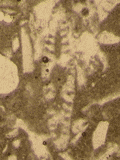 Abstract: This work is a new but minor
contribution to the récolement of Juliette Pfender's collection of
fossil green algae. It aims to establish a partial inventory of the green algae
studied by this female researcher mostly renowned for her studies on red algae.
The poor preservation of some thin sections and the scarcity of whole specimens
only rarely allow the identification of the taxa at the level below the genus. Abstract: This work is a new but minor
contribution to the récolement of Juliette Pfender's collection of
fossil green algae. It aims to establish a partial inventory of the green algae
studied by this female researcher mostly renowned for her studies on red algae.
The poor preservation of some thin sections and the scarcity of whole specimens
only rarely allow the identification of the taxa at the level below the genus.
|
|
Carnets Geol., vol. 17, no. 14, p. 251-269
Online since December 24, 2017
|
|
Additional contributions to the knowledge of the Taquaral Member, Irati Formation (Lower Permian, Paraná Basin): Taphonomy and paleoenvironmental implications
Artur CHAHUD
| HTML  | PDF
| PDF  [2,725 KB]
| DOI: 10.4267/2042/64291 [2,725 KB]
| DOI: 10.4267/2042/64291
|
|
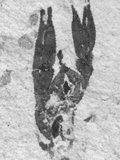 Abstract: The
silty shale facies of the Taquaral Member (Irati Formation), which is one of the
Permian units in the Brazilian Paraná Basin, is discussed here based on the
taphonomy relevant to the paleoenvironmental interpretation. The fossils are
crustaceans (Clarkecaris and other
indeterminate forms), isolated teeth, scales and bones of Actinopterygii, "Palaeonisciformes", which are the most common vertebrate remains, and also
frequent scales of Coelacanthiformes. The scales, teeth and disarticulated bones
are found together in accumulations, which may be interpreted as coprolites.
Many of the fossil crustaceans display characteristics of ecdysis. Abstract: The
silty shale facies of the Taquaral Member (Irati Formation), which is one of the
Permian units in the Brazilian Paraná Basin, is discussed here based on the
taphonomy relevant to the paleoenvironmental interpretation. The fossils are
crustaceans (Clarkecaris and other
indeterminate forms), isolated teeth, scales and bones of Actinopterygii, "Palaeonisciformes", which are the most common vertebrate remains, and also
frequent scales of Coelacanthiformes. The scales, teeth and disarticulated bones
are found together in accumulations, which may be interpreted as coprolites.
Many of the fossil crustaceans display characteristics of ecdysis.
|
|
Carnets Geol., vol. 17, no. 13, p. 243-250
Online since December 24, 2017
|
|
Cornulitids from the Upper Ordovician of northwestern Russia
Olev VINN & Anna MADISON
| HTML  | PDF
| PDF  [958 KB]
| DOI: 10.4267/2042/64289 [958 KB]
| DOI: 10.4267/2042/64289
|
|
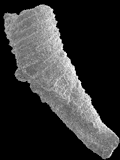 Abstract: Four
cornulitid species occur in the Rakvere Regional Stage in NW Russia. The new
species Conchicolites rossicus is here described; it is the earliest known Conchicolites
from the Ordovician of Baltica. The new species has very small tubes with sharp,
strong and regular annulations. The diversity of cornulitids in the Rakvere
Regional Stage at the Pechurki quarry is usual for the Upper Ordovician of
Baltica. The cornulitids of Pechurki quarry encrusted hard organic substrates in
a mud bottom (clay and carbonate clay) environment. Cornulites
sterlingensis occurs both in the Upper Ordovician of North America and
Baltica, which suggest a short distance between these two paleocontinents and/or
similar environmental conditions. Abstract: Four
cornulitid species occur in the Rakvere Regional Stage in NW Russia. The new
species Conchicolites rossicus is here described; it is the earliest known Conchicolites
from the Ordovician of Baltica. The new species has very small tubes with sharp,
strong and regular annulations. The diversity of cornulitids in the Rakvere
Regional Stage at the Pechurki quarry is usual for the Upper Ordovician of
Baltica. The cornulitids of Pechurki quarry encrusted hard organic substrates in
a mud bottom (clay and carbonate clay) environment. Cornulites
sterlingensis occurs both in the Upper Ordovician of North America and
Baltica, which suggest a short distance between these two paleocontinents and/or
similar environmental conditions.
|
|
Carnets Geol., vol. 17, no. 12, p. 235-241
Online since December 24, 2017
|
|
Mecaster texanus (Echinoidea) from Turonian-Coniacian strata in the Sergipe-Alagoas Basin, Brazil
Cynthia L. de C. MANSO & Wagner SOUZA-LIMA
| HTML  | PDF
| PDF  [1,325 KB]
| DOI: 10.4267/2042/64287 [1,325 KB]
| DOI: 10.4267/2042/64287
|
|
 Abstract: The spatangoid echinoid Mecaster texanus (Roemer) was first
described from the Austin Chalk in Texas (USA). In northeast Brazil, this
species was recorded from the Upper Cretaceous (Turonian-Coniacian) Jandaíra
Formation in the Potiguar Basin. Here we extend the palaeogeographical
distribution of M. texanus southwards to the Sergipe-Alagoas
Basin, where this species occurs in the Turonian-Coniacian Cotinguiba Formation.
A key to identification of spatangoids from the Cretaceous-Cenozoic sequence at
Sergipe-Alagoas is added and considerations about other spatangoid species from
that basin are presented. Abstract: The spatangoid echinoid Mecaster texanus (Roemer) was first
described from the Austin Chalk in Texas (USA). In northeast Brazil, this
species was recorded from the Upper Cretaceous (Turonian-Coniacian) Jandaíra
Formation in the Potiguar Basin. Here we extend the palaeogeographical
distribution of M. texanus southwards to the Sergipe-Alagoas
Basin, where this species occurs in the Turonian-Coniacian Cotinguiba Formation.
A key to identification of spatangoids from the Cretaceous-Cenozoic sequence at
Sergipe-Alagoas is added and considerations about other spatangoid species from
that basin are presented.
|
|
Carnets Geol., vol. 17, no. 11, p. 221-234
Online since December 24, 2017
|
|
Palynology and sedimentary environments of the Devonian from the Saida area (northwestern Algeria)
Mohammed BOUGARA, Philippe STEEMANS, Alain LE HÉRISSÉ & Frédéric BOULVAIN
| HTML  | PDF
| PDF  [1,679 KB]
| DOI: 10.4267/2042/64285 [1,679 KB]
| DOI: 10.4267/2042/64285
|
|
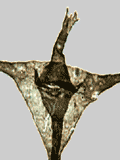 Abstract: Palynological interpretations of
both spores and acritarchs from the Devonian Tiffrit Formation located in Saïda
(North-Western Algeria) support identical conclusions. Species of spores and acritarches that appear in the upper
layers of the younger reference unit, named Boukourdène (BK1), are compatible
with a Pragian-Emsian age, based especially on the presence of the
miospores Dibolisporites wetteldorfensis, Dictyotriletes emsiensis,
D. subgranifer, Verrucosisporites polygonalis, and the
acritarchs Evittia crucistellata, E. spicifera, Fimbriaglomerella
aulerca, Florisphaeridium toyetae, and Veryhachium aff. V.
vandenbergheni. Abstract: Palynological interpretations of
both spores and acritarchs from the Devonian Tiffrit Formation located in Saïda
(North-Western Algeria) support identical conclusions. Species of spores and acritarches that appear in the upper
layers of the younger reference unit, named Boukourdène (BK1), are compatible
with a Pragian-Emsian age, based especially on the presence of the
miospores Dibolisporites wetteldorfensis, Dictyotriletes emsiensis,
D. subgranifer, Verrucosisporites polygonalis, and the
acritarchs Evittia crucistellata, E. spicifera, Fimbriaglomerella
aulerca, Florisphaeridium toyetae, and Veryhachium aff. V.
vandenbergheni.
On the basis of occurrences of
microconglomeratic levels with elements of Silurian phtanites found along the
sedimentary units of Tiffrit, we consider that Silurian sediments as well as
Lower Devonian sediments have been reworked. We thus propose a Praguian-Emsian age for the Boukourdène
units.
From
a sedimentological point of view, the Devonian sedimentary units of the Tiffrit
Massif are linked to a gravitational deposition controlled by sea
level rise and significant subsidence. Facies
seems to change along an East-West axis. The particle size, the nature of
the facies, and their extreme variability over short distances indicate a slope
apron environment of deposition.
The lithological, sedimentological and environmental characteristics of the
studied system are consistent with deposition in an active tectonic margin
setting.
|
|
Carnets Geol., vol. 17, no. 10, p. 191-219
Online since December 24, 2017
|
|
GSSP proposal for the upper Aptian substage in the Apt Basin (Vaucluse, SE France): Synthesis of the stratigraphic data
Michel MOULLADE, Guy TRONCHETTI, Christine BALME, Yves DUTOUR, Pierre ROPOLO, Gregory PRICE, Mathieu MARTINEZ & Bruno GRANIER
| HTML  | PDF
| PDF  [2,338 KB]
| DOI: 10.4267/2042/62954 [2,338 KB]
| DOI: 10.4267/2042/62954
|
|
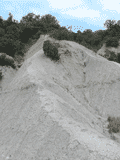 Abstract: The synthesis of the stratigraphic data collected over more than a decade in
the stratotypic area has made it possible to establish a composite section of
the "Aptian marls" from the Grandis ammonite Subzone to the base of
the Melchioris Zone, i.e., from the Schackoina
(Leupoldina) gr. cabri
foraminiferal Zone to the Globigerinelloides
algerianus Zone. This composite section includes the partial sections from
Clavaillan, South and East Pichouraz, La Tuilière, Les Gays and Gargas
(Vaucluse, SE France). In particular, our revision has shown that the marly
calcareous bed, which divides the marly series of Clavaillan and Pichouraz,
compared with the Vocontian "Niveau blanc" and thought to be unique and isochronous, corresponds in
fact to two stratigraphically distinct levels. Abstract: The synthesis of the stratigraphic data collected over more than a decade in
the stratotypic area has made it possible to establish a composite section of
the "Aptian marls" from the Grandis ammonite Subzone to the base of
the Melchioris Zone, i.e., from the Schackoina
(Leupoldina) gr. cabri
foraminiferal Zone to the Globigerinelloides
algerianus Zone. This composite section includes the partial sections from
Clavaillan, South and East Pichouraz, La Tuilière, Les Gays and Gargas
(Vaucluse, SE France). In particular, our revision has shown that the marly
calcareous bed, which divides the marly series of Clavaillan and Pichouraz,
compared with the Vocontian "Niveau blanc" and thought to be unique and isochronous, corresponds in
fact to two stratigraphically distinct levels.
The present study confirms that the visible series of marls in the stratotypic area, not
taking into account the "A1" supra-Urgonian formation of Leenhardt
(1883), includes only the uppermost terms of the Bedoulian and the lower terms
(= Lower and Middle Gargasian) of the Aptian s.s. (i.e., sensu Orbigny, 1840).
Based on the methods of integrated stratigraphy, a comparison of the
series of the Apt Basin with the contemporary terms of the Cassis-La Bédoule
Basin has also made it possible to detect and quantify important variations in
the rhythms of sedimentary accumulation between the two sectors. In the end,
the Clavaillan section, located 8 km WSW from the Gargas section, is the only
outcrop where the boundary between the Grandis Subzone and the Furcata Zone is
visible in a context which supports a proposal that this exposure be a
candidate for the GSSP of the Gargasian substage (or of the Aptian s.s. in the initial concept of the creator of the stage).
|
|
Carnets Geol., vol. 17, no. 9, p. 161-189
Online since October 20, 2017
|
|
Revision of the Barrande's specimen "Tige d'une Cystidée indéterminée" (Cambrian, Echinodermata, Eocrinoidea)
Martina NOHEJLOVÁ & Oldřich FATKA
| HTML  | PDF
| PDF  [548 KB]
| DOI: 10.4267/2042/62768 [548 KB]
| DOI: 10.4267/2042/62768
|
|
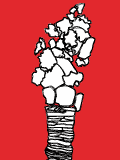 Abstract: Reexamination of the type
specimen described
by Barrande in 1887 as "Tige d'une
Cystidée indéterminée" shows that this unique specimen represents an
articulated but incomplete remnant of the gogiid eocrinoid Akadocrinus
jani Prokop. The
specimen is preserved as an external mould in shale from the mid-Cambrian Jince
Formation, and comprises a proximal part of a stem associated with a slightly
disarticulated distal portion of a theca, composed of over twenty polygonal
plates. With the exception of the basal-most plates, all other preserved thecal
plates bear ellipsoidal marginal epispires, and substantiate assignment of this
specimen to the epispire-bearing phase in ontogenetic development of Akadocrinus. Abstract: Reexamination of the type
specimen described
by Barrande in 1887 as "Tige d'une
Cystidée indéterminée" shows that this unique specimen represents an
articulated but incomplete remnant of the gogiid eocrinoid Akadocrinus
jani Prokop. The
specimen is preserved as an external mould in shale from the mid-Cambrian Jince
Formation, and comprises a proximal part of a stem associated with a slightly
disarticulated distal portion of a theca, composed of over twenty polygonal
plates. With the exception of the basal-most plates, all other preserved thecal
plates bear ellipsoidal marginal epispires, and substantiate assignment of this
specimen to the epispire-bearing phase in ontogenetic development of Akadocrinus.
|
|
Carnets Geol., vol. 17, no. 8, p. 153-160
Online since October 16, 2017
|
|
Rare rugosan-bryozoan intergrowth from the Upper Ordovician of Estonia
Olev VINN, Andrej ERNST & Ursula TOOM
| HTML  | PDF
| PDF  [1,517 KB]
| DOI: 10.4267/2042/62664 [1,517 KB]
| DOI: 10.4267/2042/62664
|
|
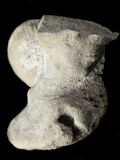 Abstract: Two
relatively large specimens of the rugosan Lambelasma
sp. are fully intergrown with the bryozoan Stigmatella
massalis colony. The intergrown specimen occurs in the Oandu Regional Stage
(lower Katian) of Estonia and constitutes the earliest record of
bryozoan-rugosan intergrowth from Baltica. Most likely this symbiotic
association was accidental. Rugosans presumably benefitted from the bryozoan,
which served as an anchor to stabilize them in hydrodynamically active waters.
The lack of malformations and no decrease in the size of bryozoan zooids near
the rugosans indicate a lack of negative effect of the rugosans on the bryozoan.
Bryozoan-rugosan symbiosis is only known from the Ordovician of Baltica and
Laurentia. Abstract: Two
relatively large specimens of the rugosan Lambelasma
sp. are fully intergrown with the bryozoan Stigmatella
massalis colony. The intergrown specimen occurs in the Oandu Regional Stage
(lower Katian) of Estonia and constitutes the earliest record of
bryozoan-rugosan intergrowth from Baltica. Most likely this symbiotic
association was accidental. Rugosans presumably benefitted from the bryozoan,
which served as an anchor to stabilize them in hydrodynamically active waters.
The lack of malformations and no decrease in the size of bryozoan zooids near
the rugosans indicate a lack of negative effect of the rugosans on the bryozoan.
Bryozoan-rugosan symbiosis is only known from the Ordovician of Baltica and
Laurentia.
|
|
Carnets Geol., vol. 17, no. 7, p. 145-151
Online since October 16, 2017
|
|
The most distal moldavite findings from Lower Silesia, Poland
Tomasz BRACHANIEC
| HTML  | PDF
| PDF  [1,366 KB]
| DOI: 10.4267/2042/62663 [1,366 KB]
| DOI: 10.4267/2042/62663
|
|
 Abstract: The
present note reports new findings of moldavites from southwestern
Poland. The material was found in the Nowa Wieś Kącka sandpit. To
date, it represents the most distal locality where moldavites have been found.
These moldavites, like other moldavites previously described from Lower Silesia,
are recovered from fluvial sands and gravels of the Gozdnica Formation. Like
other Polish moldavites, the moldavites in this study display high SiO2
contents (~77 wt.%). Their dimensions range from 9 to 11 mm in maximum diameter.
Their relatively large sizes suggest that the distribution of Polish tektites
defines a sub-strewnfield larger than previously expected. Abstract: The
present note reports new findings of moldavites from southwestern
Poland. The material was found in the Nowa Wieś Kącka sandpit. To
date, it represents the most distal locality where moldavites have been found.
These moldavites, like other moldavites previously described from Lower Silesia,
are recovered from fluvial sands and gravels of the Gozdnica Formation. Like
other Polish moldavites, the moldavites in this study display high SiO2
contents (~77 wt.%). Their dimensions range from 9 to 11 mm in maximum diameter.
Their relatively large sizes suggest that the distribution of Polish tektites
defines a sub-strewnfield larger than previously expected.
|
|
Carnets Geol., vol. 17, no. 6, p. 139-144
Online since October 16, 2017
|
|
Importance of the Quatrehomme collection (Monnaye Museum, Meung-sur-Loire) in the French palaeontological landscape
Morgane DUBIED, Charlène GILBERT, Maxime DELÉGLISE, Flavie LAURENS & Bastien MENNECART
| HTML  | PDF
| PDF  [528 KB]
| DOI: 10.4267/2042/62541 [528 KB]
| DOI: 10.4267/2042/62541
|
|
 Abstract: The Quatrehomme collection is described by
Ginsburg as "modest to very modest" and there is no accurate
inventory. In
order to highlight this collection and better understand its importance, an
inventory of the terrestrial mammal remains is in progress. In the current state
of the inventory 35 different locations were identified, mostly in the Savigné-sur-Lathan
Basin. 3,266 specimens, covering 8 of the 9 orders of terrestrial mammals found
in the Faluns, are currently registered in the data set. To date, the most
impressive published Faluns mammal collections are from Hartmann, hosted at the
volunteer "Musée du Savignéen" (Savigné-sur-Lathan) and Bourgeois
(today
splitted in different museums). While this Hartmann's collection contains 1,475
mammal remains (marine and terrestrial) and Bourgeois' one 1850
(only terrestrial), we estimate that the Quatrehomme collection encompasses more than
7,500 terrestrial specimens. It is the largest known Faluns collection of Pliopithecus
(25 specimens) and of Lagomorpha (1,355 specimens). Also, eight Tapiroidea
specimens (including a jaw with teeth) and three Chalicotherium
remains are inventoried. This collection is now being studied in detail. In the next
few years it will take a more prominent place in the French paleontological
landscape. Abstract: The Quatrehomme collection is described by
Ginsburg as "modest to very modest" and there is no accurate
inventory. In
order to highlight this collection and better understand its importance, an
inventory of the terrestrial mammal remains is in progress. In the current state
of the inventory 35 different locations were identified, mostly in the Savigné-sur-Lathan
Basin. 3,266 specimens, covering 8 of the 9 orders of terrestrial mammals found
in the Faluns, are currently registered in the data set. To date, the most
impressive published Faluns mammal collections are from Hartmann, hosted at the
volunteer "Musée du Savignéen" (Savigné-sur-Lathan) and Bourgeois
(today
splitted in different museums). While this Hartmann's collection contains 1,475
mammal remains (marine and terrestrial) and Bourgeois' one 1850
(only terrestrial), we estimate that the Quatrehomme collection encompasses more than
7,500 terrestrial specimens. It is the largest known Faluns collection of Pliopithecus
(25 specimens) and of Lagomorpha (1,355 specimens). Also, eight Tapiroidea
specimens (including a jaw with teeth) and three Chalicotherium
remains are inventoried. This collection is now being studied in detail. In the next
few years it will take a more prominent place in the French paleontological
landscape.
|
|
Carnets Geol., vol. 17, no. 5, p. 128-138
Online since September 12, 2017
|
|
New stratigraphic and genetic model for the dolomitic Cretaceous Pinda reservoirs in Angola. Part I - The Pinda of Angola, an integrated lithostratigraphic approach
Bruno GRANIER
| HTML  | PDF
| PDF  [6,754 KB]
| DOI: 10.4267/2042/62283 [6,754 KB]
| DOI: 10.4267/2042/62283
|
|
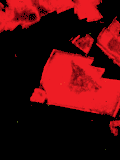 Abstract: The Pinda Group of the Congo basin
in the northern Angolan offshore is an overall transgressive supersequence of late Aptian - ? early Cenomanian age. Due to synsedimentary salt tectonics of the underlying Loeme Salt,
the original ramp arrangement is split into discrete structures corresponding to many proven, probable and possible oil and gas plays. Where the biostratigraphic information was not
destroyed by pervasive dolomitization, the little that remains is not available to the general public because it is treated as proprietary data by the Sociedade Nacional de Combustíveis
de Angola Empresa Pública – Sonangol E.P. Only a limited set of data containing lithostratigraphic information
(e.g., some published well logs and photomicrographs of facies) is
available. The aim of this paper is to give a little more information about the Pinda stratigraphy. For instance, to be formally defined, this poorly known unit required a type section,
a shortcoming that is addressed here. The wireline log signatures of some regional seismic markers are documented because they are used to correlate wells and subdivide the Group into
formations. The microfacies corresponding to some key electrofacies as well as the porosity types are also condensed in a microphotograph catalog. Finally, few examples of typical LoC
(i.e., Line of Correlation) diagrams are displayed and interpreted. Abstract: The Pinda Group of the Congo basin
in the northern Angolan offshore is an overall transgressive supersequence of late Aptian - ? early Cenomanian age. Due to synsedimentary salt tectonics of the underlying Loeme Salt,
the original ramp arrangement is split into discrete structures corresponding to many proven, probable and possible oil and gas plays. Where the biostratigraphic information was not
destroyed by pervasive dolomitization, the little that remains is not available to the general public because it is treated as proprietary data by the Sociedade Nacional de Combustíveis
de Angola Empresa Pública – Sonangol E.P. Only a limited set of data containing lithostratigraphic information
(e.g., some published well logs and photomicrographs of facies) is
available. The aim of this paper is to give a little more information about the Pinda stratigraphy. For instance, to be formally defined, this poorly known unit required a type section,
a shortcoming that is addressed here. The wireline log signatures of some regional seismic markers are documented because they are used to correlate wells and subdivide the Group into
formations. The microfacies corresponding to some key electrofacies as well as the porosity types are also condensed in a microphotograph catalog. Finally, few examples of typical LoC
(i.e., Line of Correlation) diagrams are displayed and interpreted.
|
|
Carnets Geol., vol. 17, no. 4, p. 105-127
Online since June 25, 2017
|
|
Sedimentological investigation on Holocene deposits in the Mussafah channel (Abu Dhabi, United Arab Emirates)
Bruno GRANIER & Robert BOICHARD
| HTML  | PDF
| PDF  [21,535 KB]
| DOI: 10.4267/2042/62267 [21,535 KB]
| DOI: 10.4267/2042/62267
|
|
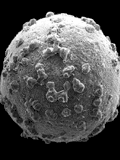 Abstract: Eight macrofacies types (5) plus subtypes (3) were identified while measuring sections along the Mussafah channel profile. These include: Abstract: Eight macrofacies types (5) plus subtypes (3) were identified while measuring sections along the Mussafah channel profile. These include:
• aeolian sands,
• microbial mat and microbial-laminated sediments,
• gypsum and enterolithic anhydrite, i.e., a diagenetic variation of the previous facies,
• muds with small pelecypods, and • its seagrass meadow version,
• Potamid sands, and • its cemented version, i.e., the Potamid beach-rock,
• washover fan coquina.
A complete set of analyses, including granulometry, mineral composition, clay composition, TOC, and identification of the allochems and the microfossils, was performed on this material. The facies and their genetic setting, i.e., the sequence of facies, provide a perspective on both the environmental and stratigraphical significance of their distribution, both lateral and vertical, and an example of the application of the Walther's law. The lower microbial mat is the mark of a transgression whereas the upper microbial mat is the mark of a forced regression. In conclusion, the sequence of facies allows identification of the last Holocene transgressive-regressive cycle that includes a forced regression, which probably dates back to 6,000 years BP.
|
|
Carnets Geol., vol. 17, no. 3, p. 39-104
Online since June 25, 2017
|
|
Biostratigraphy and paleoenvironmental reconstruction of the marine lower Miocene Chechiș Formation in the Transylvanian Basin based on foraminiferal assemblages
Szabolcs-Flavius SZÉKELY, Raluca BINDIU-HAITONIC, Sorin FILIPESCU & Răzvan BERCEA
| HTML  | PDF
| PDF  [3,045 KB]
| DOI: 10.4267/2042/62041 [3,045 KB]
| DOI: 10.4267/2042/62041
|
|
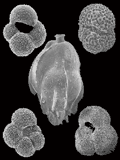 Abstract: Planktonic and benthic foraminiferal assemblages were used for biostratigraphy
and paleoenvironmental reconstruction of the marine lower Miocene Chechiș
Formation from the Gălpâia section (Sălaj county, Romania) in the
northwestern Transylvanian Basin. Planktonic foraminifera suggest an
Eggenburgian (Burdigalian) age for the deposits studied and reveal episodes of
high primary productivity and mostly cool surface waters. Benthic foraminiferal assemblages indicate paleoenvironmental deepening from outer
shelf to upper bathyal settings. Deltaic influences may be observed at the
base of the studied section in outer shelf (possibly upper bathyal)
environments with oxygenated bottom water and episodic high primary
productivity, as a consequence of nutrient input from the land. Changes in
paleobathymetry resulted in reduction of primary productivity. The benthic
assemblages from the uppermost part of the section are dominated by tubular
agglutinated foraminifera and indicate an upper bathyal setting with low
organic flux to the sea floor. The sediments of the studied section were
deposited during the late stage of the first early Miocene relative sea-level
rise in the Transylvanian Basin. Abstract: Planktonic and benthic foraminiferal assemblages were used for biostratigraphy
and paleoenvironmental reconstruction of the marine lower Miocene Chechiș
Formation from the Gălpâia section (Sălaj county, Romania) in the
northwestern Transylvanian Basin. Planktonic foraminifera suggest an
Eggenburgian (Burdigalian) age for the deposits studied and reveal episodes of
high primary productivity and mostly cool surface waters. Benthic foraminiferal assemblages indicate paleoenvironmental deepening from outer
shelf to upper bathyal settings. Deltaic influences may be observed at the
base of the studied section in outer shelf (possibly upper bathyal)
environments with oxygenated bottom water and episodic high primary
productivity, as a consequence of nutrient input from the land. Changes in
paleobathymetry resulted in reduction of primary productivity. The benthic
assemblages from the uppermost part of the section are dominated by tubular
agglutinated foraminifera and indicate an upper bathyal setting with low
organic flux to the sea floor. The sediments of the studied section were
deposited during the late stage of the first early Miocene relative sea-level
rise in the Transylvanian Basin.
|
|
Carnets Geol., vol. 17, no. 2, p. 11-37
Online since March 24, 2017
|
|
Review of the early Albian ammonites of the Montmell Formation near Marmellar (Salou-Garraf Basin, Tarragona, Catalonia, Spain)
Josep A. MORENO-BEDMAR, Emmanuel ROBERT, Rafel MATAMALES-ANDREU & Telm BOVER-ARNAL
| HTML  | PDF
| PDF  [1,482 KB]
| DOI: 10.4267/2042/62038 [1,482 KB]
| DOI: 10.4267/2042/62038
|
|
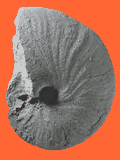 Abstract: In this work, we review the ammonites of the Montmell Formation in the Marmellar
area
housed in the collections of the Museo Geológico del Seminario de Barcelona and
the Museu de Geologia de Barcelona. This taxonomic update allows the proper
biostratigraphic analysis of the ammonite assemblage and assigns it to the early
Albian, Leymeriella tardefurcata Zone. The taxonomic analysis of all the
studied material allows us to recognize the presence of the following taxa: Uhligella
sp., Parengonoceras bassei, Hypacanthoplites
plesiotypicus, Hypacanthoplites
milletianus, Hypacanthoplites
subelegans, and Hypacanthoplites
sp. The current work is a step forward in the chronostratigraphic knowledge of
the Salou-Garraf Basin in the Catalan Coastal Ranges. Abstract: In this work, we review the ammonites of the Montmell Formation in the Marmellar
area
housed in the collections of the Museo Geológico del Seminario de Barcelona and
the Museu de Geologia de Barcelona. This taxonomic update allows the proper
biostratigraphic analysis of the ammonite assemblage and assigns it to the early
Albian, Leymeriella tardefurcata Zone. The taxonomic analysis of all the
studied material allows us to recognize the presence of the following taxa: Uhligella
sp., Parengonoceras bassei, Hypacanthoplites
plesiotypicus, Hypacanthoplites
milletianus, Hypacanthoplites
subelegans, and Hypacanthoplites
sp. The current work is a step forward in the chronostratigraphic knowledge of
the Salou-Garraf Basin in the Catalan Coastal Ranges.
|
|
Carnets Geol., vol. 17, no. 1, p. 1-10
Online since March 24, 2017
|
|
|
|